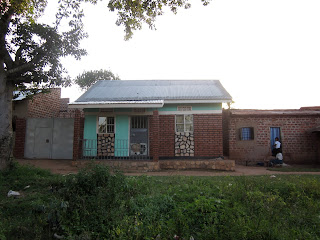This past weekend, I spent a really fascinating and relaxing Shabbat with the Jewish community of Uganda. Yes, for those who don’t know, there are really Ugandan Jews! They live in five small villages outside the northwest city of Mbale (about 4 hours from Kampala), and today they number about 1500. Apparently, the story goes that about 100 years ago, a man named Semei secluded himself from his community, read the bible, and decided he liked the Old Testament better than the new one. And that was that.
After traveling 1.5 hours on two “taxis” (mini-buses) from Namayumba to Kampala, another 4.5 hours on a (bigger) bus from Kampala to Mbale, and about ten minutes on a boda-boda (motorcycle taxi), I arrived in Nabugoye, the central village of the Abayudaya. I was greeted by Isaac, the manager of the guesthouse, as well as two other American Jewish volunteers who are staying there for some months. (Naturally, we spent a good while playing some intense Jewish Geography games of who-knows-who—shout-outs to Jews I know at Princeton and Neta Raanan-Lerner, if you ever come across this—and I felt immediately at home.) The guesthouse was a real treat. Running water, comfortable beds, tile floors, and three really hearty meals that included all sorts of delicious fruit and Ugandan peanut butter (which was a first for me)!! It was a nice break from my usual posho (corn-meal type thing) and beans twice a day. The village itself, too, was gorgeous—the area is surrounded by mountains and the air felt fresher out there, far from the busy-ness and dust of Kampala.
Friday night and Saturday morning I attended services at their synagogue –
On Friday evening they did Kabbalat Shabbat and then Maariv, and on Saturday they had Shacharit, a Torah service, and then Musaf. The services followed the Sim Shalom siddur and it all seemed familiar and traditional. They used several common melodies and also incorporated some beautiful original ones—and even sang some psalms in Luganda (the local language), which was all quite interesting. In terms of religiosity, they consider themselves to be conservative. Though men and women sit separately, women can lead services and read Torah, etc – and I was honored with an aliyah J. (Honorary Abayudaya here.) They also seemed to keep Shabbat pretty strictly, which I found out while trying to take a picture (yikes).
Rabbi Gershom, the one ordained Rabbi of the Abayudaya, was really welcoming and engaging. He studied at American Jewish University in California and in Israel, and then returned to lead his community. After services on Saturday morning, he led a large discussion with everyone about the Parashah – Korach – which turned into a passionate and exciting debate about punishment, death, and God’s powers to destroy. The whole thing felt very Jewish—the way he encouraged disagreement, posed un-answerable questions, and made the learning a truly communal experience. I liked it; it was nice to be a part of when education here (from what I’ve seen/understood) often involves tons of lecturing, copying, memorizing, and repeating.
All in all, it was strange but exciting to be in a place that was at once so foreign and yet so close to home. The little kippahs the boys wore, the dancing during L’cha Dodi, the anxious (and often drool-inducing) wait to taste the challah after the motzie, were all things I knew from thousands of miles away—from a place with wireless internet and porcelain toilet seats and white people that don’t immediately stand out as mzungu!!’s. I grew comfortable so fast, and wish I could have stayed longer. It’s true, I suppose, what they taught me at Grossman: “Wherever you go, there’s always someone Jewish, You’re never alone when you say you’re a Jew, so when you’re not home and you’re someplace kinda new-ish… the odds are, don’t look far, cuz they’re Jewish too!” [I could insert lyrics from Yavneh’s “Minyan Man” as well, but honestly that song’s about Alabama, and I’m halfway across the world here. It doesn’t apply quite as well.]
This could be my last blog entry while in Uganda, as I return home on Wednesday (bitter-sweet feelings all around), but I’ll for sure add some closing remarks from home. Which will of course be supa exciting so be on your toes. Thanks for following my travels – I’m excited to see Boston again and everyone at home!














